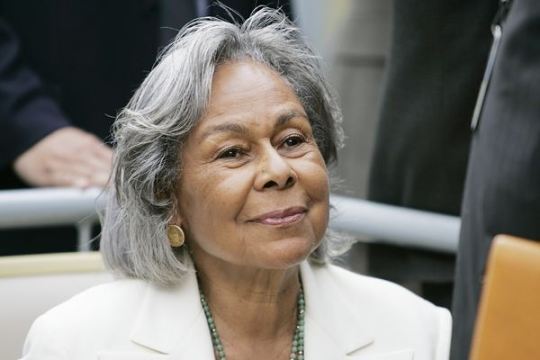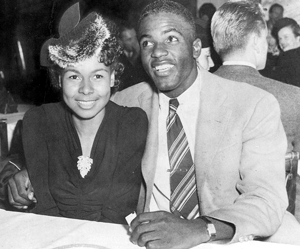There's a wonderful scene in Ken Burns' new documentary, Jackie Robinson, where Barack and Michelle Obama explain the important role that Rachel Robinson played in her husband's success on and off the baseball field.
"I think anytime you're involved in an endeavor that involves enormous stress, finding yourself questioned in terms of whether you should be where you are, to be able to go back and have refuge with someone who you know loves you and you know has your back, that's priceless," the President says. The First Lady adds: "There's nothing more important than family - than a real partnership. Which is probably what made him such a great man."
One-upped, the president nods in agreement, with a knowing smile on his face. Then the First Lady completes her thought: "It's a sign of his character that he chose a woman who was his equal. I don't think you would've had Jackie Robinson without Rachel."
In Burns' two-part PBS documentary Jackie Robinson -- which airs Monday and Tuesday nights and which was co-directed with Sarah Burns and David McMahon -- Rachel Robinson finally gets her due. Through much of the film, we see Jackie -- who broke Major League Baseball's color line in 1947 with the Brooklyn Dodgers -- through her eyes. Nearing 94 years old, Rachel has a remarkable memory for details, including the travails and triumphs that she and Jackie shared during and after his playing days.
Until now, much of what Americans know about Rachel Robinson is what they've seen in the two major Hollywood films about Jackie. She was portrayed by Ruby Dee in the 1950 film, The Jackie Robinson Story, and by Nicole Beharie in the 2013 hit movie, 42. Both films depict Rachel as Jackie's supporter, cheerleader, and helpmate, the person who comforted him when he faced abuse, and encouraged him when he was feeling discouraged.
This is all true, but it is an incomplete picture of this remarkable woman. Rachel Robinson was not only Jackie's partner, she is also the person who has kept his legacy alive. Since his death in 1972, Rachel has continued Jackie's commitment to pushing Major League Baseball to hire more people of color as managers and as executives.
In 1997, when the entire country was celebrating the 50th anniversary of Jackie's triumph in breaking baseball's color line, Rachel made sure that the celebration did not divert attention from ongoing problems.
When a Los Angeles Times reporter asked her if Jackie would be pleased with the status of race relations today, Rachel didn't pull her punches. She said:
"No, I think he'd be very disturbed about it. We're seeing a great deal of divisiveness, a lot of hatred, a lot of tension between ethnic groups, and I think he'd be disappointed."
Thanks to her efforts, most of today's Major League players, managers, and executives know that they stand on the shoulders of those, like Jackie, who came before them and opened doors for them.
In 2014, the Baseball Reliquary inducted Rachel into its Shrine of the Eternals, an alternative Hall of Fame that celebrates baseball's rebels and renegades. By doing so, the group (which is coincidentally based in Pasadena, Jackie's hometown) was acknowledging that although she didn't own a team, cover the game as a reporter, or play the game herself, she was one of the most important woman in baseball history.
But outside of the baseball world, too, Rachel Robinson has been, in her own right, a pioneer for social justice on several fronts, using her celebrity as a platform to fight for a more equal society.
Rachel Isum was born in 1922. She grew up in a house on 36th Place on LA's west side.
In the early 1920s, Los Angeles was racially segregated. It still had restrictive covenants, prohibiting the sale of houses to African Americans in certain neighborhoods. To get around that obstacle, Rachel's parents -- Charles and Zellee -- arranged for a light-skinned black man to buy the house and then re-sell it to them. This was a risky and courageous thing to do at a time when the Ku Klux Klan had a presence in LA.
In 1940, African Americans comprised only four percent of Los Angeles' population of 1.5 million. Growing up in LA's predominantly white west side, Rachel faced bigotry on a regular basis. For example, when Rachel and her friends went to the movies, they were regularly directed to the balcony in the movie theater.
Rachel's father had served in World War One. On his last day of active service, he was gassed, leaving him permanently disabled and with a chronic heart condition. By the time Rachel was in high school, her father had to quit his job as a bookbinder for the Los Angeles Times, where he'd worked for 25 years.
As a result, Rachel's mother had to support the family. She took classes in baking and cake decorating and had her own business catering luncheons and dinner parties for wealthy families in Beverly Hills, Bel Air, and Hollywood.
Rachel worked, too. She helped her mother with her catering business, worked on Saturdays at the concession stand in the public library, and sewed baby clothes for the National Youth Administration, part of Franklin Roosevelt's New Deal program.
Rachel graduated from Manual Arts High School in June 1940. That fall, she entered UCLA's highly selective and competitive five-year nursing program. In 1940, only five percent of all women -- and less than two percent of black women -- earned a college degree. But Rachel didn't let those odds get in her way.
She met Jackie in 1941 when they were both students at UCLA. They were introduced by Ray Bartlett, one of Jackie's friends from Pasadena who also went to UCLA.
Jackie was already a multi-sport campus hero by the time he met Rachel. For their first date, Jackie took Rachel to a Bruin football dinner at the Biltmore Hotel in downtown LA. But much of their courtship took place at Kerckhoff Hall, the student union, where the small number of UCLA's African American students gathered in-between classes. Rachel and Jackie got engaged later that year.
While at UCLA, Rachel lived at home and commuted to the campus each day.
She also worked at night. This was during World War Two, and local industries were hiring women to do what had previously been considered "men's" jobs.
Rachel was hired as a riveter at the Lockheed Aircraft factory in LA, where they made airplanes for the war effort. She worked the night shift, drove to UCLA at dawn, changed clothes in the parking lot, and then went to class.
Rachel and Jackie promised their parents that they wouldn't get married until Rachel had completed her degree. She earned her nursing degree in June 1945. They were married the following February.
By then, Jackie had already served in the military (where he was court-martialed, and acquitted , for refusing to move to the back of a segregated bus near a military base in Texas), played in the Negro Leagues, and signed a contract to play with the Dodgers' minor league team in Montreal.
Two weeks after their marriage, Rachel and Jackie left for spring training in Daytona, Florida with the Montreal Royals. Burns' documentary portrays, through Rachel's voice, the ordeal they faced dealing with the Southern Jim Crow system, including the segregated trains, buses, restaurants, and stadiums, and the hostility of many white Southerners.
To get to Daytona, they flew from LA to New Orleans. At the New Orleans airport, they were told they were being "bumped" from the plane to Florida. Jackie protested this obvious racist act to the airline attendant behind the counter.
Meanwhile, Rachel escaped to the Ladies Room. But there were two Ladies Rooms in the airport, right next to each other. One said "Colored Women." The other said "White Women." Rachel went into the one that said "White Women." People stared at her, but nobody stopped her.
Nine years before Rosa Parks triggered the Montgomery Bus Boycott, Rachel Robinson had performed her first act of civil disobedience.
For the next 11 years -- until Jackie retired from Major League Baseball in 1957 -- Rachel and Jackie together endured the humiliations and bigotry, and celebrated the triumphs and accolades, of being civil rights pioneers.
Roger Wilkins, a Pulitzer Prize-winning journalist, wrote this about Rachel:
She was not simply the dutiful little wife. She was Jack's co-pioneer. She had to live through the death threats, endure the vile screams of the fans and watch her husband get knocked down by pitch after pitch. And because he was under the strictest discipline not to fight, spike, curse or spit back, she was the one who had to absorb everything he brought home. She was beautiful and wise and replenished his strength and courage.
In addition, she was primarily responsible for raising their three children -- Jackie Junior, Sharon, and David.
While Jackie played for the Dodgers, they first lived in Brooklyn, and then in Long Island. Then they tried to buy a home in suburban Purchase, New York. After Rachel offered the asking price, the house was taken off the market, and she knew why.
In 1955, they found a plot of land they liked in Stamford, Connecticut and built a new home in that suburban community. When the news had spread that the Robinsons had bought the property, several families on the block sold their homes.
The Robinsons settled in, made friends, became active in the community. But they couldn't escape the racism.
When a white friend attempted to sponsor Jackie at the local country club, he was rejected by a majority vote. Jackie was already a bona fide national celebrity who had won the MVP award, but the white country clubbers didn't think he was good enough to play golf with them.
After Jackie retired from baseball in 1957, he began a new career in business, and expanded his involvement with the NAACP and other civil rights groups.
At that time, Rachel decided to resume her professional career. This was five years before Betty Friedan's book, The Feminine Mystique, ignited the women's movement. Rachel was an early feminist.
Jackie was upset by Rachel's decision to go back to school and back to work, but Rachel insisted that it was something she needed to do. Eventually, Jackie came around.
In 1959 -- at age 37 -- Rachel was admitted to the graduate program in psychiatric nursing at New York University.
After earning her master's degree, Rachel worked as a nurse-therapist and researcher at the Albert Einstein College of Medicine in New York.
In 1965, she was hired as a professor at Yale's School of Nursing and as the nursing director at the Connecticut Mental Health Center.
When Rachel was teaching at Yale, the university asked her to join its board of trustees. Rachel said no. She told Yale: "Not unless you put another black or another woman on the board. You won't get a two-fer from me."
While working full-time, Rachel remained deeply involved in her children's education and in community activities. Beginning in 1963, Jackie and Rachel hosted their legendary jazz concerts at their home as fundraisers for jailed civil rights activists.
Rachel taught at Yale and ran the state mental health center for seven years, until 1972, the year that Jackie died at age 53 of diabetes and heart disease.
After Jackie's death, she took charge of running the Jackie Robinson Development Corporation. During her ten years as its president, it built more than 1,300 units of affordable housing.
In 1973, she created the Jackie Robinson Foundation. The foundation is Jackie's living legacy and Rachel was its hands-on chair and inspiring leader.
In its 43 year existence, the foundation has provided scholarships to 1,400 college students. Each one gets $6,000 a year for four years, plus mentoring, summer jobs and internships. The foundation's goal is to help them become leaders in changing society.
Most of these students are the first in their families to attend college. Most are students of color. They have a remarkable graduation rate of 97 percent. They've gone to Harvard, Yale, Georgetown, UCLA, and many other colleges.
Rachel has received numerous awards for her activism as well as honorary degrees from eight universities. She has been invited to the White House by five presidents.
Like Jackie, she has enormous physical courage and moral integrity.
In 1997, for her 75th birthday, Rachel and a dozen family members climbed to 10,000 feet on Mount Kilimanjaro in Africa.
Rachel and Jackie Robinson were partners for 31 years, from the time they met in 1941 until Jackie's death 1972. Burns' documentary will help remind Americans about Rachel's resilience, courage, and remarkable achievements during Jackie's lifetime and in the 44 years since his passing.
Peter Dreier teaches Politics and chairs the Urban & Environmental Policy Department at Occidental College. His most recent book is The 100 Greatest Americans of the 20th Century: A Social Justice Hall of Fame (Nation Books). Jackie Robinson is one of the people profiled in the book.


